The 20th century witnessed profound cultural reactions that reshaped the arts, literature, and intellectual movements across Europe. Driven by seismic events like the World Wars, the Great Depression, and the rise of totalitarian regimes, these reactions are essential to understanding AP European History. Modernism, Surrealism, Existentialism, Postmodernism, and Feminist Movements emerged, each challenging traditional norms and exploring new ways of thinking. These cultural shifts offer invaluable insights into how societies coped with and interpreted the tumultuous changes of the century.
Learning Objectives
In AP European History, understanding 20th-century cultural reactions requires focusing on key movements such as Modernism, Surrealism, Existentialism, and Postmodernism. Identify each movement’s characteristics, influences, and significant figures, while analyzing how historical events like World War I, World War II, and the Cold War shaped these cultural reactions. Recognize how these developments connect with broader social, political, and economic contexts, enhancing your analytical and critical thinking skills for the exam.
Modernism (Early 20th Century)
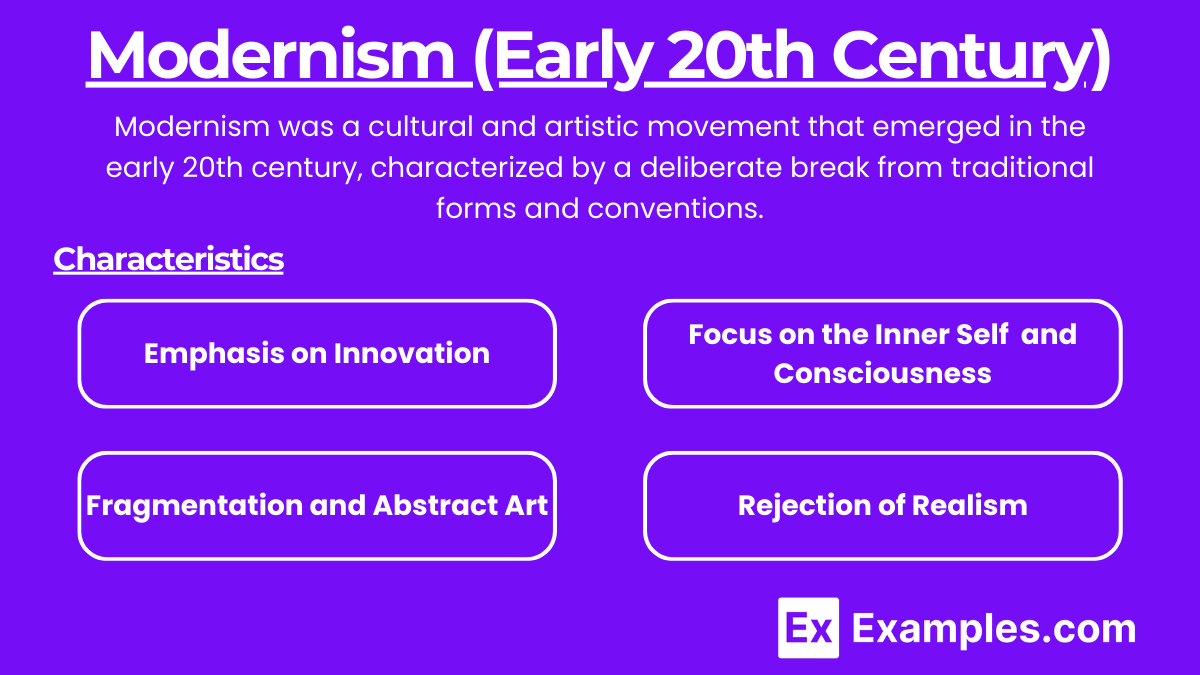
Modernism was a cultural and artistic movement that emerged in the early 20th century, characterized by a deliberate break from traditional forms and conventions. It sought to capture the essence of modern life, emphasizing new techniques, abstraction, and experimentation. Modernism reflected a sense of disillusionment with established norms, influenced by rapid industrialization, urbanization, and the horrors of World War I.
Characteristics
- Emphasis on Innovation: Modernism rejected traditional forms and embraced new techniques in art, literature, and architecture.
- Focus on the Inner Self and Consciousness: Writers like James Joyce and Virginia Woolf explored stream-of-consciousness techniques.
- Fragmentation and Abstract Art: Artists like Pablo Picasso and Georges Braque developed Cubism, breaking objects into fragmented shapes.
- Rejection of Realism: Modernist works often featured abstract or surreal elements.
Influences
- Industrialization: Rapid technological advancements and urbanization.
- Psychoanalysis: Sigmund Freud’s theories on the unconscious mind influenced modernist literature and art.
- World War I: The devastation and disillusionment caused by the war led to a rejection of previous norms and conventions.
Key Figures
- Literature: T.S. Eliot, Franz Kafka, James Joyce, Virginia Woolf.
- Art: Pablo Picasso, Georges Braque, Marcel Duchamp.
- Architecture: Le Corbusier, Walter Gropius.
Surrealism (1920s-1930s)
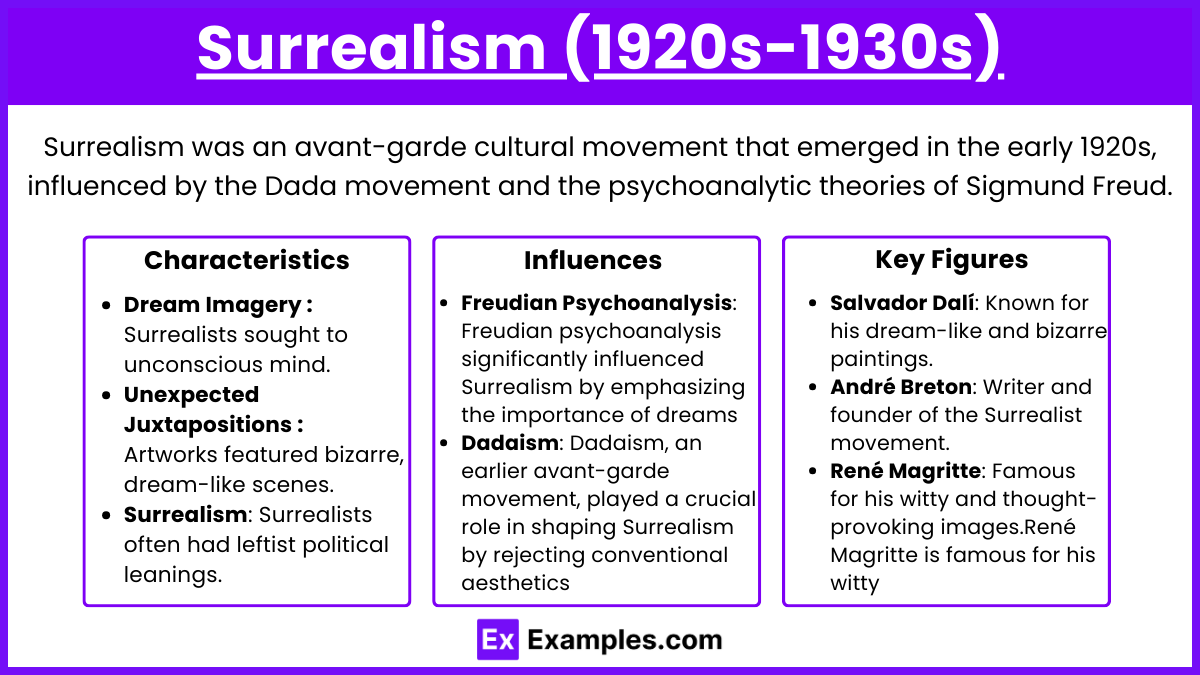
Surrealism was an avant-garde cultural movement that emerged in the early 1920s, influenced by the Dada movement and the psychoanalytic theories of Sigmund Freud. It aimed to unlock the power of the unconscious mind and liberate the imagination from rational thought. Surrealists sought to merge dream and reality, creating works that defied logic and conventional aesthetics.
Characteristics
- Dream Imagery: Surrealists sought to unleash the creative potential of the unconscious mind.
- Unexpected Juxtapositions: Artworks featured bizarre, dream-like scenes.
- Political and Social Revolution: Surrealists often had leftist political leanings.
Influences
- Freudian Psychoanalysis: Freudian psychoanalysis significantly influenced Surrealism by emphasizing the importance of dreams and the unconscious mind.
- Dadaism: Dadaism, an earlier avant-garde movement, played a crucial role in shaping Surrealism by rejecting conventional aesthetics and embracing chaos and irrationality.
Key Figures
- Salvador Dalí: Known for his dream-like and bizarre paintings. Salvador Dalí is renowned for his dream-like and bizarre paintings that vividly capture the essence of Surrealism.
- André Breton: Writer and founder of the Surrealist movement. André Breton, a French writer and poet, is considered the founder and principal theorist of the Surrealist movement.
- René Magritte: Famous for his witty and thought-provoking images.René Magritte is famous for his witty and thought-provoking images that challenge viewers’ perceptions of reality.
Existentialism (Post-World War II)
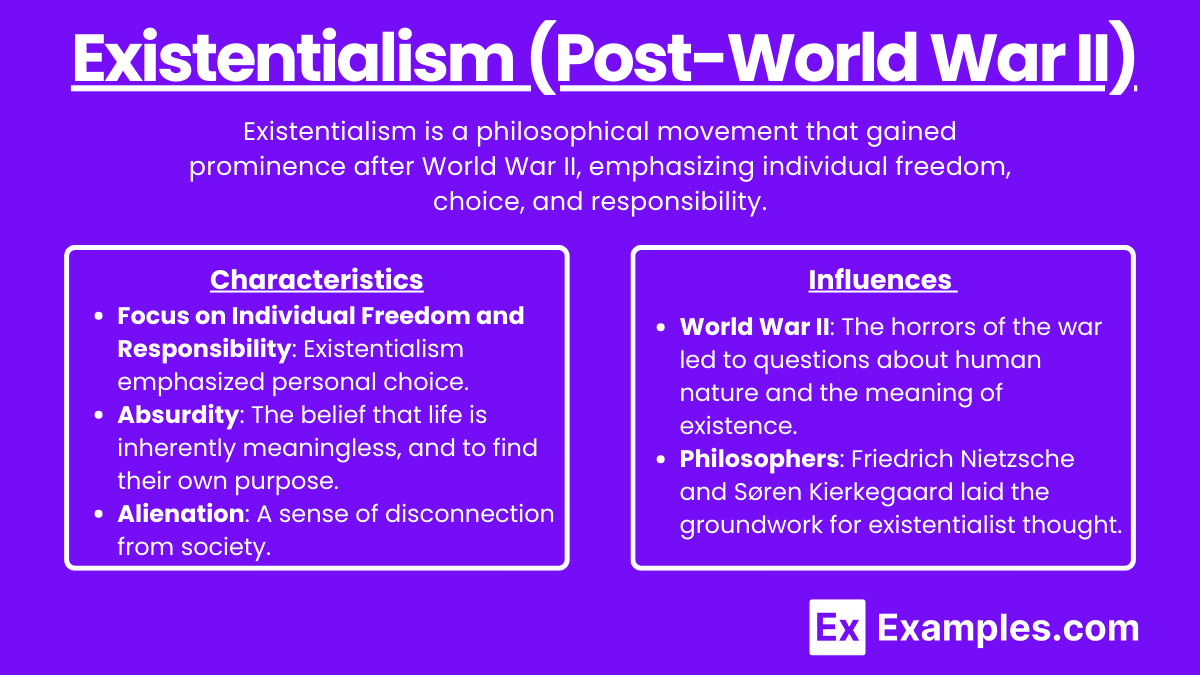
Existentialism is a philosophical movement that gained prominence after World War II, emphasizing individual freedom, choice, and responsibility. It explores the human condition, the meaning of life, and the experience of existence in an indifferent or even absurd universe.
Characteristics
- Focus on Individual Freedom and Responsibility: Existentialism emphasized personal choice and the search for meaning.
- Absurdity: The belief that life is inherently meaningless, and it is up to individuals to find their own purpose.
- Alienation: A sense of disconnection from society.
Influences
- World War II: The horrors of the war led to questions about human nature and the meaning of existence.
- Philosophers: Friedrich Nietzsche and Søren Kierkegaard laid the groundwork for existentialist thought.
Key Figures of Existentialism
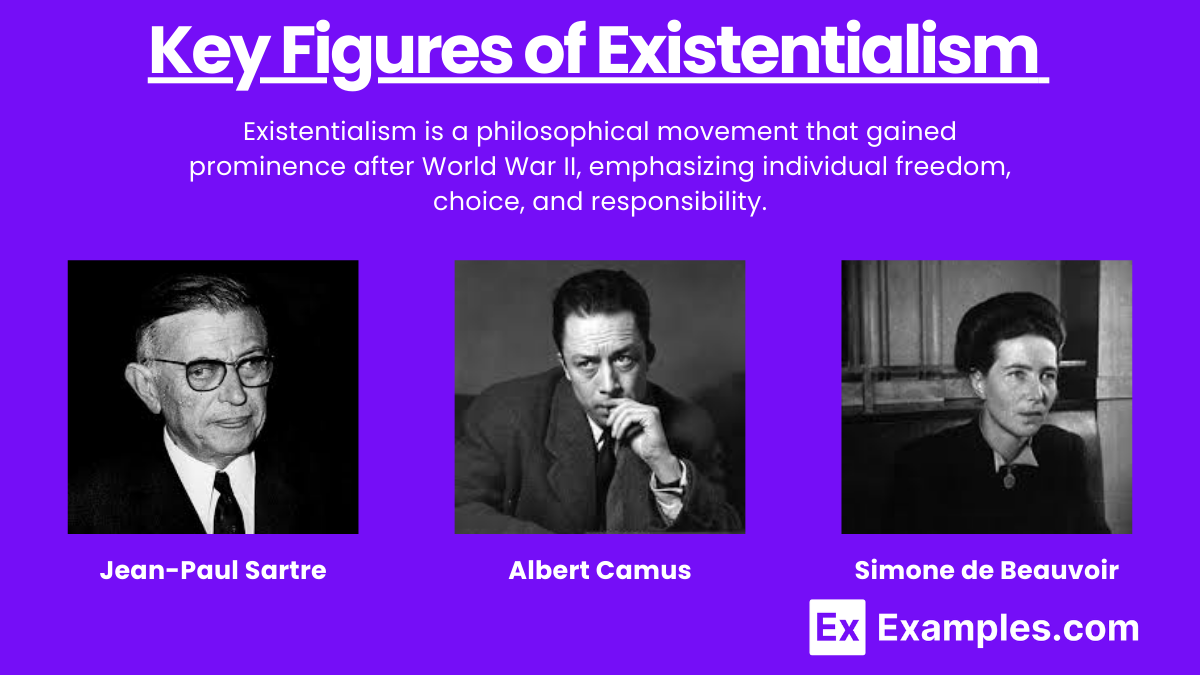
- Jean-Paul Sartre: Philosopher who wrote about existentialism and human freedom.
- Albert Camus: Author of “The Stranger” and “The Myth of Sisyphus,” which explore themes of absurdity and existentialism.
- Simone de Beauvoir: Philosopher and feminist who wrote “The Second Sex,” examining women’s oppression.
Postmodernism (Late 20th Century)

Postmodernism is a broad and complex movement that emerged in the late 20th century as a reaction against modernism. It is characterized by a skeptical and questioning attitude towards grand narratives, ideologies, and the idea of objective truth. Postmodernism embraces relativism, diversity, and the deconstruction of traditional structures in art, literature, and philosophy.
Characteristics
- Skepticism towards Grand Narratives: Postmodernists questioned overarching stories and ideologies.
- Intertextuality: Works often referenced other texts, creating a web of connections.
- Playfulness and Irony: A playful approach to serious subjects, often using irony and pastiche.
Influences
- Modernism: A Reaction Against the Seriousness and Elitism of Modernist Art and Literature. Postmodernism emerged as a reaction against the perceived seriousness and elitism of modernist art and literature.
- Technological Advancements: The rise of digital media and globalization profoundly influenced postmodernism. The late 20th century saw rapid advancements in technology, particularly in the fields of communication and media.
Key Figures
- Literature: Thomas Pynchon, Don DeLillo, Italo Calvino, Kurt Vonnegut, Angela Carter.
- Art: Andy Warhol, Robert Rauschenberg, Cindy Sherman, Jean-Michel Basquiat, Barbara Kruger.
- Architecture: Philip Johnson, Robert Venturi, Frank Gehry, Zaha Hadid.
Feminist Movements (20th Century)
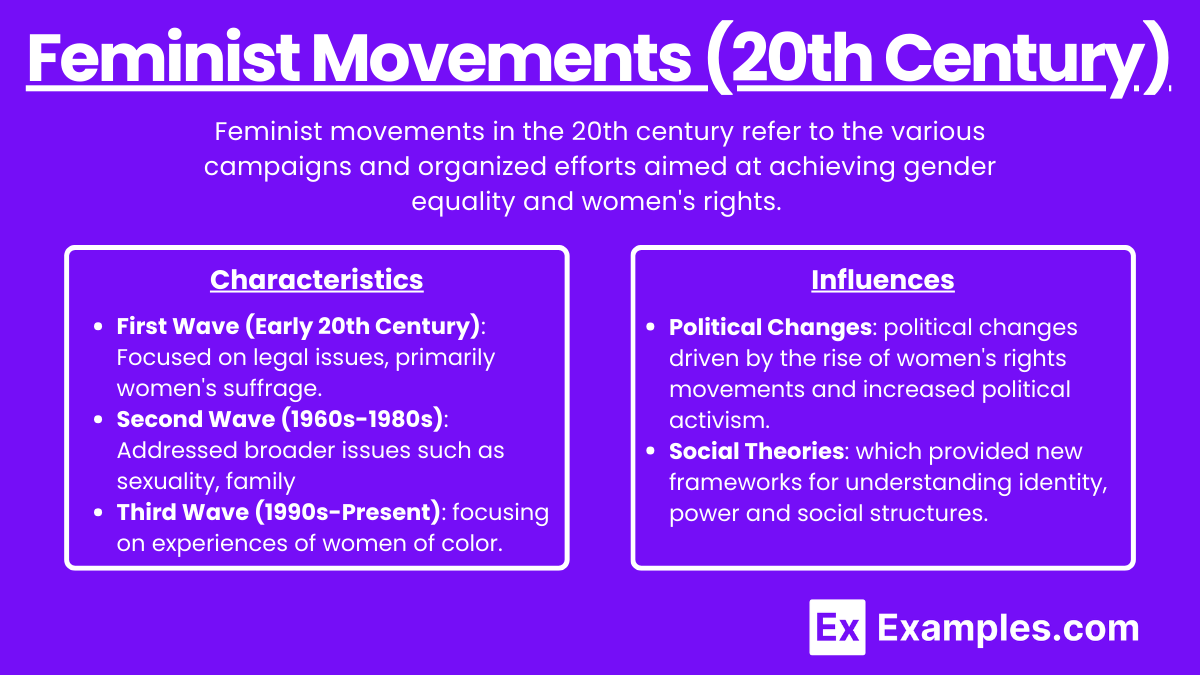
Feminist movements in the 20th century refer to the various campaigns and organized efforts aimed at achieving gender equality and women’s rights. These movements sought to address systemic gender-based discrimination and advocated for social, political, economic, and cultural changes to improve the status and conditions of women in society. Feminism during this period evolved through multiple waves, each with distinct focuses and strategies to combat the prevailing issues faced by women.
Characteristics
- First Wave (Early 20th Century): Focused on legal issues, primarily women’s suffrage.
- Second Wave (1960s-1980s): Addressed broader issues such as sexuality, family, and workplace rights.
- Third Wave (1990s-Present): Emphasized diversity and intersectionality, focusing on the experiences of women of color, LGBTQ+ women, and other marginalized groups.
Influences
- Political Changes: The 20th century witnessed significant political changes driven by the rise of women’s rights movements and increased political activism.
- Social Theories: Feminist movements of the 20th century were profoundly shaped by existentialism and postmodernism, which provided new frameworks for understanding identity, power, and social structures.
Key Figures of Feminist Movements
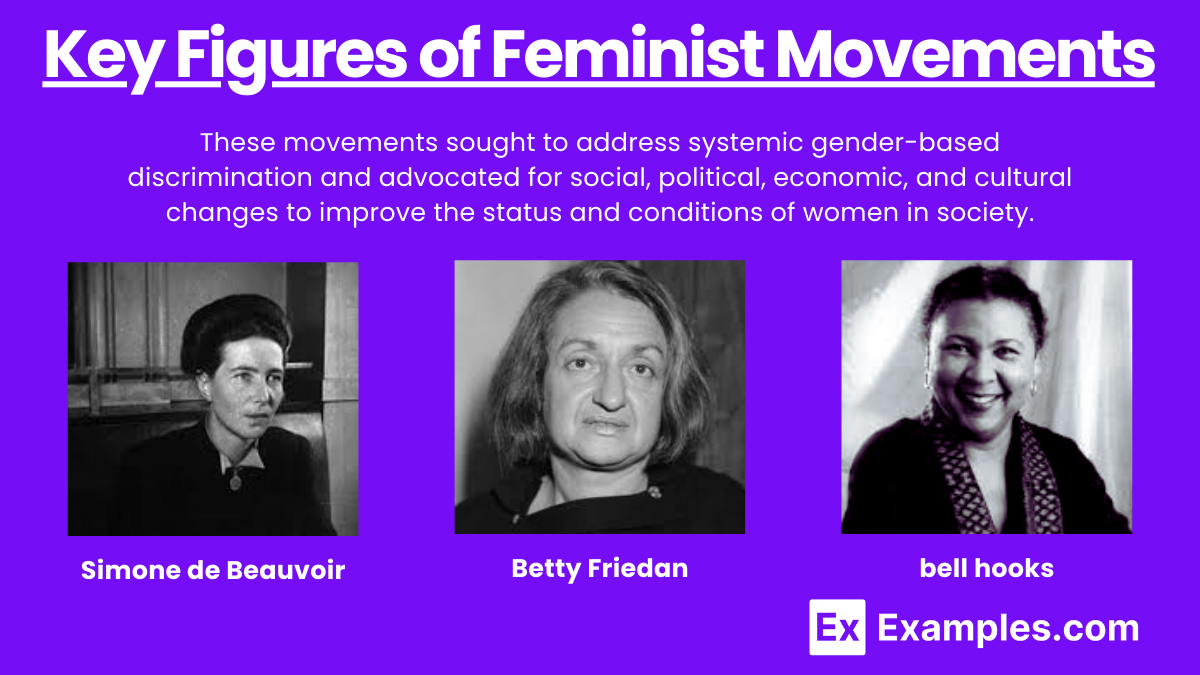
- Simone de Beauvoir: Author of “The Second Sex,” which challenged traditional gender roles.
- Betty Friedan: Wrote “The Feminine Mystique,” which sparked the second wave of feminism.
- bell hooks: An influential third-wave feminist thinker and writer.
Cultural Reactions to Totalitarianism
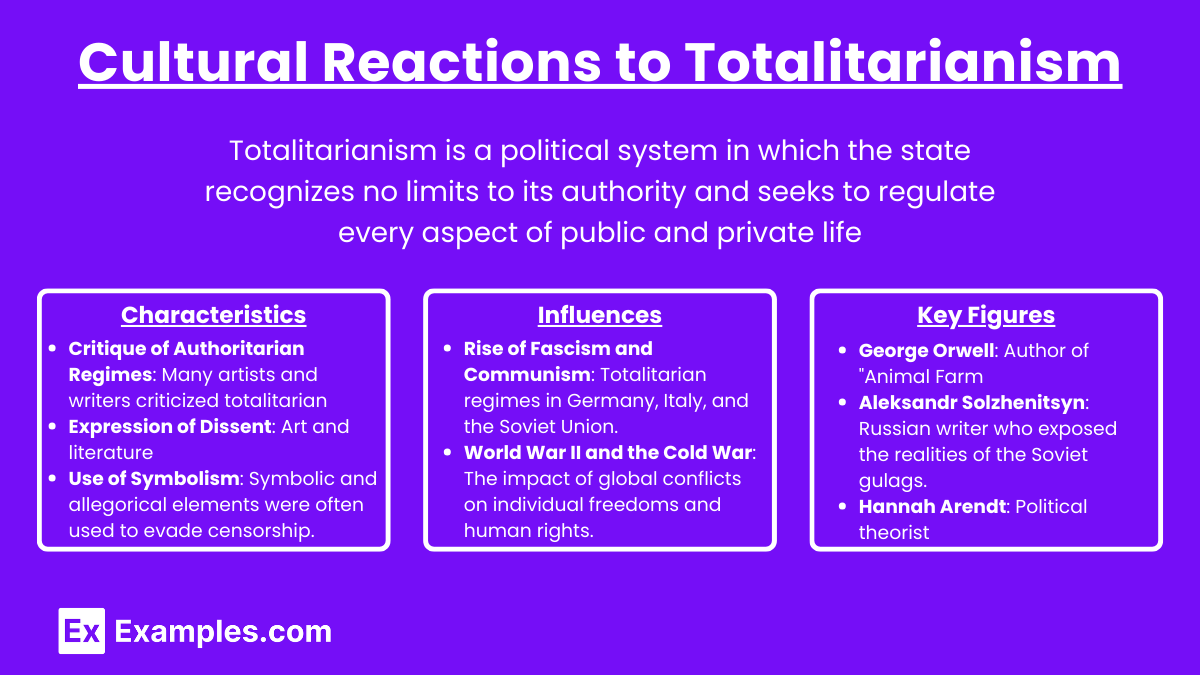
Totalitarianism is a political system in which the state recognizes no limits to its authority and seeks to regulate every aspect of public and private life. During the 20th century, Europe saw the rise of totalitarian regimes in Nazi Germany, Fascist Italy, and Stalinist Soviet Union.
Characteristics
- Critique of Authoritarian Regimes: Many artists and writers criticized totalitarian regimes through their works.
- Expression of Dissent: Art and literature became a means of expressing dissent and resistance.
- Use of Symbolism: Symbolic and allegorical elements were often used to evade censorship.
Influences
- Rise of Fascism and Communism: Totalitarian regimes in Germany, Italy, and the Soviet Union.
- World War II and the Cold War: The impact of global conflicts on individual freedoms and human rights.
Key Figures
- George Orwell: Author of “1984” and “Animal Farm,” which critiqued totalitarianism.
- Aleksandr Solzhenitsyn: Russian writer who exposed the realities of the Soviet gulags.
- Hannah Arendt: Political theorist who wrote extensively on totalitarianism.
Understanding the cultural reactions of the 20th century is essential for mastering AP European History. These movements reflect the profound changes and challenges of the time, offering insights into how individuals and societies responded to rapid transformations. By studying the characteristics, influences, and key figures of each movement, you can gain a comprehensive understanding of this dynamic period in European history.
Examples
Example 1. Harlem Renaissance
A 1920s cultural revival in Harlem, New York, celebrating African American art, literature, and music. Key figures: Langston Hughes, Zora Neale Hurston.
Example 2. Beat Generation
1950s American writers rejecting societal norms, promoting spiritual liberation and self-expression. Notable members: Jack Kerouac, Allen Ginsberg.
Example 3. Civil Rights Movement
1950s-60s movement to end racial segregation and discrimination against African Americans. Key figures: Martin Luther King Jr., Rosa Parks.
Example 4. Counterculture Movement
1960s reaction against Vietnam War, consumerism, and traditional norms, embracing peace and alternative lifestyles. Highlight: Woodstock Festival.
Example 5. Feminist Movement
1960s-70s push for gender equality, reproductive rights, and workplace fairness. Key milestones: Betty Friedan’s “The Feminine Mystique,” National Organization for Women (NOW).
Multiple Choice Questions
Question 1
Which of the following movements is most closely associated with the 20th-century cultural reaction against traditional artistic norms?
A. Impressionism
B. Renaissance
C. Modernism
D. Romanticism
Answer: C. Modernism
Explanation: Modernism emerged as a significant cultural and artistic movement in the late 19th and early 20th centuries, reacting against traditional artistic norms and conventions. It was characterized by a deliberate break from classical and traditional forms, embracing experimentation and a new approach to literature, art, and music. Modernists sought to capture the essence of modern life, often focusing on themes of alienation, fragmentation, and disillusionment. This was in stark contrast to movements like Impressionism, Renaissance, and Romanticism, which adhered more closely to traditional forms and subjects.
Question 2:
The Harlem Renaissance was a cultural reaction in the 20th century that primarily highlighted the experiences and contributions of which group?
A. Asian Americans
B. African Americans
C. Native Americans
D. European immigrants
Answer: B. African Americans
Explanation: The Harlem Renaissance was a cultural, social, and artistic explosion that took place in Harlem, New York, during the 1920s. It was a significant cultural reaction that highlighted the experiences, contributions, and talents of African Americans. This movement included writers, artists, musicians, and thinkers who sought to redefine African American identity and culture, challenge racial stereotypes, and promote civil rights. Key figures included Langston Hughes, Zora Neale Hurston, and Duke Ellington. The Harlem Renaissance played a crucial role in shaping the cultural landscape of the United States and fostering a sense of pride and empowerment within the African American community.
Question 3:
Which of the following best describes the cultural reaction of postmodernism in the late 20th century?
A. A return to classical ideals and forms
B. A focus on narrative coherence and singular truth
C. An embrace of pastiche, irony, and multiple perspectives
D. A rejection of technology and industrialization
Answer: C. An embrace of pastiche, irony, and multiple perspectives
Explanation: Postmodernism emerged in the late 20th century as a cultural reaction to modernism and the perceived limitations of its ideals. Postmodernists embraced pastiche, irony, and the mixing of different styles and genres. They rejected the idea of a single, overarching narrative or truth, instead celebrating multiple perspectives and fragmented narratives. This movement often incorporated self-referential and playful elements, questioning established conventions and exploring the boundaries between high and low culture. Unlike modernism, which sought to find deeper meaning in the chaos of modern life, postmodernism acknowledged and embraced the chaotic, often contradictory nature of contemporary existence.


